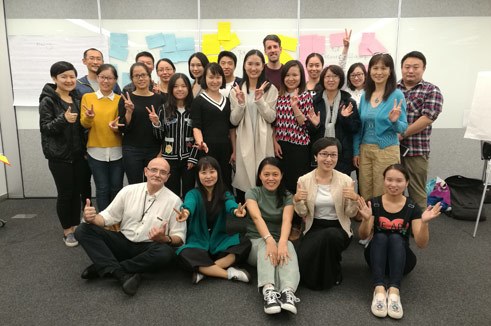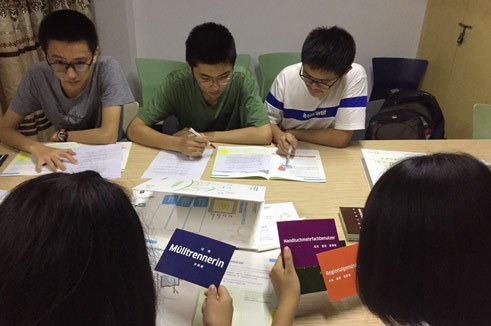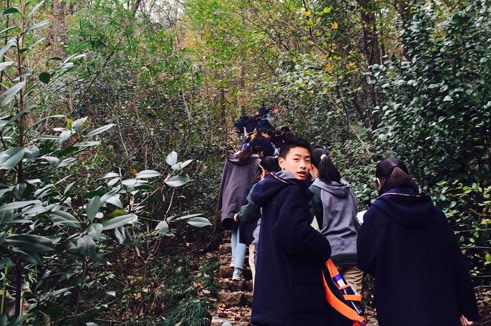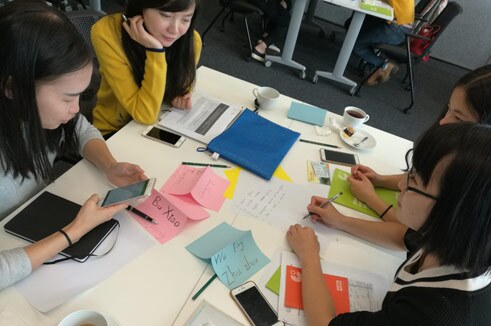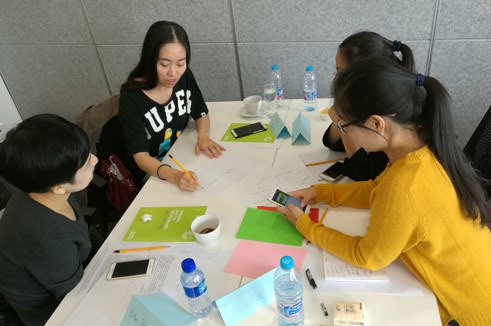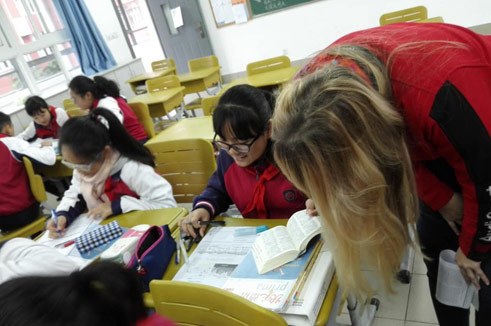Rainer E. Wicke, Oliver Müller
Interdisciplinary gfl lessons as one variant of CLIL
definition, objectives and Methods
This article explores FüDaF, a German acronym referring to the interdisciplinary teaching of German as a foreign language, as one variant of CLIL. Based on its definition, the objectives of such lessons are illustrated. In addition, examples are used to show which principles of FüDaF teaching are important and which methods are necessary to ensure its success.
füdaf – an attempt at a definition
The term “FüDaF” has frequently been mentioned in didactic discussions over recent years – it is regarded as particularly necessary when it comes to providing certain types of lessons, such as project-based lessons for example (Legutke: 2003, p. 260). The current bilingual teaching handbook also explicitly advises integrating subject content into normal language lessons. While Wolfgang Hallet calls in the handbook for subject-based discourse abilities to be promoted (Hallet: 2013 b), p.182), Jutta Rymarczik makes a case for interdisciplinary and deeper processes of thinking and learning in normal foreign language teaching (Rymarczik: 2013, p. 268). Vollmer and Thürmann also view language education and the acquisition of academic language as a challenge for all subjects (Vollmer, Thürmann, 2013, p. 42).Interestingly, all of the above authors favour the FüDaF approach, yet it is not explicitly defined in the cited literature. A more comprehensive definition is crucial, however, especially when it comes to selecting content and formulating FüDaF goals on this basis. In this context, Dagmar Osterloh’s definition of the term is helpful: she characterizes FüDaF as “topic-centred integrative teaching” (Osterloh: cf. article in the CLIL magazine). Nonetheless, the “equal participation of all subjects” that is likewise mentioned there is called into question to the extent that FüDaF – in contrast to bilingual teaching with an immersive orientation and German-language content teaching (known in German as DFU) – is a language-focused variant (Wicke: 2015, p. 26). First and foremost, FüDaF is therefore a foreign-language German lesson that incorporates aspects of the subject content:
What characterizes interdisciplinary German teaching is that consideration is given to the content and peculiarities of the technical language used in other subjects – including art, music, physics, chemistry, biology, geography, history etc. – in foreign-language German lessons. Lessons that are based on these principles give pupils the chance to acquire corresponding skills in open teaching and learning scenarios, such as (literary) project lessons (Wicke: 2013, p. 26).
Although FüDaF relies on support from the content of the individual subjects, and although content and language learning are interlinked, it is and remains language teaching. Nonetheless, ritualized foreign language teaching is broadened by the inclusion of subject-specific content, meaning that FüDaF plays a bridging role on the path towards a bilingual immersion approach (Wicke, Rottmann, 2013, p.11). This role is particularly important in those countries and regions in which subjects are not taught according to CLIL methods, as FüDaF can allow learners to acquire at least rudimentary subject-specific knowledge. In FüDaF, the foreign language – especially in project-based learning – is not only the subject of the lesson but also a fundamental and authentic means of communication for pupils and teachers; in other words, it is at once the medium and the content.
requirements for FüDaF and its objectives
Integrating cultural and technical language aspectsLooking at more recent framework plans and curricular, it can be noted that systematic consideration of foreign language and (subject) content learning has been called for, thereby influencing FüDaF too (ZfA: 2009, p. 6). The Common European Framework of Reference for Languages (CEFR) is by no means satisfied with only the principles of language acquisition and its teaching either. Instead, the expectation is explicitly formulated that pupils should be able to express their views on certain cultural topics (Council of Europe: 2001, p.170 and p. 81). Accordingly, Bonnet and Breidbach demand that the boundaries between subjects be broken up (Bonnet/Breidbach, 2013: p. 28). Britta Hufeisen talks in this context of a more intensive technical language functionalization of the foreign language lesson (Hufeisen: 2005, p.14 and Hufeisen: 2011, p. 274); Bernt Ahrenholz assumes that German as a second language (GSL) and GFL lessons help pupils acquire the predominant usage patterns of the subject in question (Ahrenholz: 2010, p.111).
It can be seen from the cited sources that didactic experts support the establishment of a FüDaF approach that gives consideration to cultural topics and incorporates the foreign language aspects of the subject teaching. A glance at the textbooks currently available on the market is enough to reveal that initial steps have been taken but that the examples are frequently limited to the subjects of art and music (e.g. Koithan et al.: 2015, p.104/105).
one objective of FüDaF – consideration of topics relevant to the real world
The fact that using texts and topics of relevance to the real world helps motivate pupils to participate more actively in language lessons is something that was already stressed when the communicative pragmatic approach was introduced (Wicke: 2012, p. 20). At that time, however, foreign language German lessons still differed very significantly from lessons in other subjects. When Wolfgang Hallet now demands that important real-world topics and discourse be included in CLIL lessons – something that also applies especially to FüDaF – this constitutes a significant change in this respect (Hallet: 2013 b), p.184). In this context, he calls for consideration to be given to texts written in everyday language that convey an idea of their meaning and models for “translating” the subject-specific knowledge into real-world contexts (Hallet: 2013 a), p. 204).Eike Thürmann goes even further, emphasizing the importance of task-based learning in CLIL work (Thürmann: 2013, p. 232). It is particularly important in task-based learning to work on topics and content that are embedded within the lives of the learners.
a further objective – Intercultural Learning also and particularly in FüDaF
One new aspect of the expert discussion of CLIL is also the consideration given to intercultural learning in those variants of CLILiG that include FüDaF: another important objective of BU (bilingual teaching – author’s note) is intercultural learning. The idea in this context is for pupils, by exploring the subject content from multiple perspectives, to engage with their own experiences, the world they live in themselves, and their own cultural sphere, as well as with the perspective of the target language culture and society (Fehling: 2010, p.182). That aspects of the foreign culture can be accessed by pupils on the basis of their own experiences and their own cultural sphere has long been a principle of planning and design of GFL teaching. Many teachers are bound to be confused by the idea that this can also be applied to integrated content learning in the foreign language. As we will see below, however, this kind of approach is definitely possible, as a project in which the Goethe-Institut China played a key role clearly shows.yet another objective – the acquisition of subject-based discourse ability
As already mentioned above, many school learning environments around the world do not by any means have established forms of content and language integrated learning. However, this should and must not mean that learners there are denied the chance to acquire subject-based discourse ability in the sense of CLIL. Instead, FüDaF should make this possible in the interests of equal educational opportunities for all pupils learning German. Helmut Vollmer has committed to this objective by emphasizing that the CLIL approach is not about acquiring isolated knowledge but about building up interconnected and linkable expert knowledge and about the ability to apply this knowledge in many different ways in relevant situations (Vollmer: 201; p. 243).Wolfgang Hallet talks in this context of foreign-language subject content literacy, a foreign language discourse ability for example in biology, history, fine art etc. (Hallet: 2013 b), p.181). This is designed to enable pupils to take part in (future) social discourse in the foreign language.
implementing FüDaF in practice based on the example of an environmental project in China
the YEAAEP Programme
In 2016, the “Youth Environment Ambassador Action & Education Program” (YEAAEP) was launched as a joint project of the Volkswagen (China) Investment Company Limited and the Goethe-Institut China. The project offers participating pupils and teachers from 24 of the 80 PASCH schools (Schools: Partners for the Future) supported by the Goethe-Institut throughout China the opportunity to become an active part of the YEAAEP environmental network and to spend a year sharing experiences and their knowledge about the topics of forest, climate and resource efficiency. In collaboration with experts in environmental and natural protection and in GFL, teacher handouts were designed that could be used by teachers within – as well as beyond – the programme to directly support their German lessons. In addition, the material is supposed to provide pupils with an incentive to use the knowledge they have acquired to develop their own environmental projects and put these into lasting practice at the local level. YEAAEP
Relevance of the topic
Environmental protection and climate change are topics of global relevance. This was also acknowledged by the countries that took part in the 2015 Climate Summit in Paris, who agreed on a treaty aimed at limiting average global warming in future to two degrees. The effects of environmental problems are especially visible to people living in countries such as China that are affected by a high level of particulate air pollution and smog. The environmental project addresses topical issues, which also explains why pupils and teachers are so willing to engage intensively with the content. By working on and implementing environmental projects via their German lessons, they are not only able to help improve their own environment but also learn to take responsibility for future generations.Learner-appropriate planning and material creation
When devising the project, compiling the material and preparing the handouts, careful consideration was given to the language proficiency of the learners, who are at levels A1 to A2. The key point when conducting learner-oriented planning of this kind is to assess which teacher activities and which materials will be best suited to ensuring the successful personal development of the pupils (Klinger: 2013, p. 44). When compiling tests and exercises in line with FüDaF, attention was paid to ensuring that both language and content-related aspects were incorporated into the modules. For example, the module on forests contains not only vocabulary and compound nouns relating to forests but also a guide to writing a poem (of just eleven words) on the subject. At the same time, the module includes factual texts such as “Die Stockwerke des Waldes” (i.e. The Storeys of the Forest) and “Rohstofflieferant Wald” (i.e. The Forest: A Source of Raw Materials). The second module on climate was also designed according to this principle.support with complex themes
Subject-related content in the handout was compiled in collaboration with experts in the area of natural and environmental protection, and in some cases put together using a variety of German-language sources. Excerpts were also taken directly from the WWF’s educational material. In some cases, texts had to be simplified because of the complexity of their content, especially in terms of the language used. So as not to overburden pupils at the aforementioned language proficiency levels, care was taken to form short and concise sentences and to use key terms and phrases. Whenever possible, original texts in their unabridged form were used, as those responsible for the project were well aware of the advantages and disadvantages of simplifying factual texts.However, this can give rise to new problems: when given texts with simplified content and specially adapted vocabulary, learners are deceived as to the actual difficulties of technical language requirements. There are led to believe that they can understand complex technical language, an illusion that is bound to be shattered sooner or later (Ohm, Kuhn, Funk: 2007, p. 99).
A conscious decision was therefore taken to ensure that the characteristic language and style used in biology or geography was preserved as far as possible. As an aid to comprehension, specific technical terms were translated into Chinese. Where texts were particularly challenging, the possibility of a complete translation into Chinese was used to allow pupils to better understand complex relationships. However, pupils were generally required to do the exercises based upon such texts in German.
giving consideration to intercultural Learning
When compiling the material, consideration was also given with different methods to the aspect of intercultural learning. For example, the handout for the climate module begins with the phenomenon of the weather in China before then focusing on climate conditions and the reasons for climate change in other countries and regions. The forest module provides a closer look not only at German but also Chinese natural parks.In this manner, pupils can use descriptive exercise material in a first step not only to learn the foreign language – in this case German – but also to acquire subject-specific knowledge. In a second step, targeted exercises allow them to reflect upon the situation in their own circumstances or home country, using the knowledge they have acquired, and then in the final step they develop measures of their own to improve environmental protection, thus transferring the knowledge to their own situation.
Forms of scaffolding
Josef Leisen recognized more than twenty years ago that pupils require certain support if they are to put what they have learnt into their own words when working with technical language, so he provided a detailed description of his methodological tools for working in content-based lessons (Leisen: 2013, p.12-97). In doing so, Leisen also provided an aid in the sense of scaffolding. The aim is to support the learning process by making available guides, food for thought and other forms of assistance. As much help is offered as pupils need to be able to complete a particular task or exercise (Thürmann: 2010, p.143-144). As soon as they are in a position to solve the problem on their own, the support structure is removed again. In line with the scaffolding principle, our handouts now provide pupils with a catalogue of tasks and exercises which help them to decode difficult texts as well as formulate texts themselves. The assistance on offer includes for example set phrases, notes about how to make notes, as well as cloze texts and instructions about how to describe a test or experiment.acquiring a subject-based discourse ability
When compiling the handouts, the project’s initiators were aware that the topics and texts in the aforementioned modules necessarily contain an extensive technical vocabulary and technical language phrases. Specific care was therefore taken to ensure that pupils were offered ways in which to acquire a subject-based discourse ability based on the design and presentation of the materials. For example, the technical terms “frog perspective”, “normal perspective” and “bird perspective” were explained on the one hand by short sentences, and were underlined on the other to highlight them as key elements of technical vocabulary. The earth’s climate zones in the second module for example were also described first in words and then highlighted in such a way that the pupils could easily prepare the respective definitions themselves. By directly applying what they have learnt to other contexts, pupils are provided with learning opportunities in which they acquire technical language and technical terms on a more or less inductive basis.Approaches for task-oriented and project-oriented learning
Care was taken in the various modules to ensure that task-oriented learning and approaches for project-oriented teaching would also be incorporated. For example, tasks in the forest module involved pupils initially reflecting on their own paper consumption or analysing how much their school consumes, and then thinking in a second step about ways to reduce this consumption. The same handout contains information about organizing a forest excursion or forest “Olympics” with special tasks for the GFL lesson. By contrast, the climate module contains project suggestions for carrying out and analysing the results of a survey on the subject of climate protection in the school or local environment. On this basis, pupils are supposed to identify significant shortcomings in their environment themselves and come up with ideas for measures to combat them, thereby contributing to the protection of the environment and nature. They are also encouraged in this context to design posters so as to pass the content they have learnt on to other classes.conclusion
In recent years, it has been demonstrated that FüDaF now has an established place in lessons, especially when it comes to integrating work in art and music. This is also reflected in the relevant publications. As yet, proof relating to other subjects that can be incorporated into FüDaF has tended to be somewhat thin on the ground.The project’s organizers came up with successful proof in two respects with the Youth Environment Ambassador Action & Education Program and the materials developed in this context: for one thing, when using the materials it becomes clear that it is possible to successfully use certain themes in FüDaF on a modular basis – for a limited period of time. The fact that this can also be achieved in groups of learners with little knowledge of German is another success in this regard. What is more, it is clear from the choice of topic that subject-specific content from the fields of biology, geography and chemistry are also suitable for use in FüDaF. In addition, the use of relevant and fascinating topics makes German as a foreign language far more interesting for pupils, making them much more willing to engage with the language via the content.
Literatur
- Bonnet, Andreas / Breidbach, Stephan: Bilingualer Unterricht: Bildungstheoretische Grundlegung, in: Hallet, Wolfgang / Königs, Frank G. (Hsg.): Handbuch Bilingualer Unterricht, Klett-Kallmeyer, Seelze, 2013, S. 26-32.
- Fehling, Sylvia: Critical Language Awareness im bilingualen Unterricht: Relevanz für die Lernenden und unterrichtliche Umsetzungsmöglichkeiten, in: Doff, Sabine: Bilingualer Sachfachunterricht in der Sekundarstufe, Narr-Verlag, Tübingen, 2010, S. 182-195.
- Hallet, Wolfgang: Fremdsprachenunterricht und Bilingualer Unterricht, in: Hallet, Wolfgang / Königs, Frank G. (Hsg.): Handbuch Bilingualer Unterricht, Klett-Kallmeyer, Seelze, 2013 a), S.180-186.
- Hallet, Wolfgang: Aufgaben- und Materialentwicklung, in: Hallet, Wolfgang / Königs, Frank G. (Hsg.): Handbuch Bilingualer Unterricht, Klett-Kallmeyer, Seelze, 2013 b), S. 202-209.
- Hufeisen, Britta: Gesamtsprachencurriculum: Einflussfaktoren und Bedingungsgefüge, in: Hufeisen, Britta / Lütjeharms, Madeline (Hsg.): Gesamtsprachencurriculum, Integrierte Sprachendidaktik, Common Curriculum, Gunter Narr – Verlag, Tübingen, 2005, S. 9-18.
- Hufeisen, Britta: Gesamtsprachencurriculum: Weitere Überlegungen zu einem prototypischen Modell, in: Baur, Rupprecht S. / Hufeisen, Britta (Hrsg.): „Vieles ist sehr ähnlich“, Individuelle und gesellschaftliche Mehrsprachigkeit als bildungspolitische Aufgabe, Schneider-Verlag, Hohengehren, Baltmannsweiler, 2011, S.265-282.
- Klinger, Udo: Kooperative Unterrichtsentwicklung, Klett-Kallmeyer-Verlag, Seelze, 2013.
- Koithan, Ute; Schmitz, Helen; Sieber, Tanja; Sonntag, Ralf: Aspekte neu, B2, Klett-Langenscheidt-Verlag, München, 2015.
- Legutke, Michael: Projektunterricht, in: Bausch, Karl-Richard / Christ, Herbert / Krumm, Hans-Jürgen (Hrsg.): Handbuch Fremdsprachenunterricht, 4. Auflage, A. Francke-Verlag, Tübingen, 2003, S.259-262.
- Leisen, Josef: Vierzig Methoden-Werkzeuge für die Sprachförderung mit Beispielen, in: ders.: Handbuch Sprachförderung im Fach – Praxismaterialien – Sprachsensibler Fachunterricht in der Praxis, Klett-Verlag, Stuttgart, 2013.
- Ohm, Udo; Kuhn, Christina; Funk, Hermann: Sprachtraining für Fachunterricht und Beruf, Waxmann-Verlag, Münster, 2007.
- Osterloh, Dagmar: Fächerübergreifender Unterricht und Projekte mit CLIL, in: Goethe- Institut (Hsg.): MINT – Lernen mit CLIL- Deutsch integriert in den Sach- und Fachunterricht
- Rymarcyk, Jutta: Didaktiken und Methodiken bilingualer Fächer, in: Hallet, Wolfgang / Königs, Frfank G. (Hrsg.): Handbuch Bilingualer Unterricht, Klett-Kallmeyer, Seelze, 2013, S.265-271).
- Thürmann, Eike: Zur Konstruktion von Sprachgerüsten im bilingualen Sachfachunterricht, in: Doff, Sabine: Bilingualer Sachfachunterricht in der Sekundarstufe, Narr-Verlag, Tübingen, 2010, S. 137 – 152.
- Thürmann, Eike: Spezifische Methoden für den Bilingualen Unterricht / CLIL, in: Hallet, Wolfgang / Königs, Frank G. (Hrsg.): Handbuch Bilingualer Unterricht, Klett-Kallmeyer, Seelze, 2013, S.229-235.
- Vollmer, Helmut – Johannes: Fachkompetenz als fachbasierte Diskursfähigkeit am Beispiel Geographie, in: Doff, Sabine: Bilingualer Sachfachunterricht in der Sekundarstufe, Narr-Verlag, Tübingen, 2010, S.242-257.
- Vollmer, Helmut – Johannes / Thürmann, Eike: Sprachbildung und Bildungssprache als Aufgabe aller Fächer der Regelschule, in: Becker-Mrotzek, Michael / Schramm, Karen / Thürmann, Eike / Vollmer, Johannes Helmut (Hrsg.): Sprache im Fach – Sprachlichkeit und fachliches Lernen, Waxmann-Verlag, Münster, 2013, S.41-57.
- Wicke, Rainer-E.: Aufgabenorientiertes und projektorientiertes Lernen im DaF-Unterricht: Genese und Entwicklung, iudicium-Verlag, München, 2012.
- Wicke, Rainer-E. / Rottmann, Karin: Musik und Kunst im Unterricht Deutsch als Fremdsprache, Cornelsen-Verlag, Berlin, 2013.
- Wicke, Rainer-E.: Fächerübergreifender DaF-Unterricht –Charakteristika, Prinzipien und Zielsetzungen, in: Haataja, Kim; Wicke, Rainer-E. (Hsg.): Sprache und Fach – Integriergtes Lernen in der Zielsprache Deutsch, Hueber-Verlag, München, 2015, S.25-31.
- Zentralstelle für das Auslandsschulwesen: Rahmenplan „Deutsch als Fremdsprache“ für das Auslandsschulwesen, Eigendruck Bundesverwaltungsamt, Köln, 2009.
about the Authors
 Foto: Rocio Sanaylan de Wicke
Dr. Rainer E. Wicke spent over twenty years working at the Central Agency for German Schools Abroad (ZfA), focusing on German as a foreign language, preparation and continuing education. He also writes on the subject of task- and project-oriented learning, which is a key prerequisite for interdisciplinary GFL teaching. He also wrote his PhD thesis on this topic, as well as further articles on the subject published by Hueber-Verlag. He has extensive experience in continuing education for teachers (in areas such as art and music, as well as history in foreign-language German lessons). As a result of his participation in the INNOCLILiG project at the universities of Tampere and Heidelberg since 2012, he deepened his focus on CLILiG. Rainer Wicke is co-editor of the Goethe-Institut’s magazine Fremdsprache Deutsch (Foreign Language German) and is also responsible for a column entitled Aus der Praxis für die Praxis (By Practitioners for Practitioners) in the association journal of the Verband Deutscher Lehrer im Ausland (VDLiA – Association of German Teachers Abroad). Contact: marawi@freenet.de
Foto: Rocio Sanaylan de Wicke
Dr. Rainer E. Wicke spent over twenty years working at the Central Agency for German Schools Abroad (ZfA), focusing on German as a foreign language, preparation and continuing education. He also writes on the subject of task- and project-oriented learning, which is a key prerequisite for interdisciplinary GFL teaching. He also wrote his PhD thesis on this topic, as well as further articles on the subject published by Hueber-Verlag. He has extensive experience in continuing education for teachers (in areas such as art and music, as well as history in foreign-language German lessons). As a result of his participation in the INNOCLILiG project at the universities of Tampere and Heidelberg since 2012, he deepened his focus on CLILiG. Rainer Wicke is co-editor of the Goethe-Institut’s magazine Fremdsprache Deutsch (Foreign Language German) and is also responsible for a column entitled Aus der Praxis für die Praxis (By Practitioners for Practitioners) in the association journal of the Verband Deutscher Lehrer im Ausland (VDLiA – Association of German Teachers Abroad). Contact: marawi@freenet.de
 Foto: Mango
Oliver Müller is a social sciences graduate with a special interest in gender studies and East Asian politics. He has worked at the Goethe-Institut China since 2013, where he expanded his knowledge of GFL, among other things. As project leader, he was responsible for the 2013/2014 German-Chinese Language Year and for staging the 2nd Festival of German Film in China. In his role as project leader at the Goethe Language Learning Centre at Qingdao University, he was additionally responsible for the further development and quality management of language teaching and testing, and for the further training of teaching staff. In August 2016 he took over as project manager of the “Youth Environment Ambassador Action & Education Program”, and is responsible for the conceptual design and implementation of the programme.
Foto: Mango
Oliver Müller is a social sciences graduate with a special interest in gender studies and East Asian politics. He has worked at the Goethe-Institut China since 2013, where he expanded his knowledge of GFL, among other things. As project leader, he was responsible for the 2013/2014 German-Chinese Language Year and for staging the 2nd Festival of German Film in China. In his role as project leader at the Goethe Language Learning Centre at Qingdao University, he was additionally responsible for the further development and quality management of language teaching and testing, and for the further training of teaching staff. In August 2016 he took over as project manager of the “Youth Environment Ambassador Action & Education Program”, and is responsible for the conceptual design and implementation of the programme.
Contact: Oliver.Mueller@goethe.de
